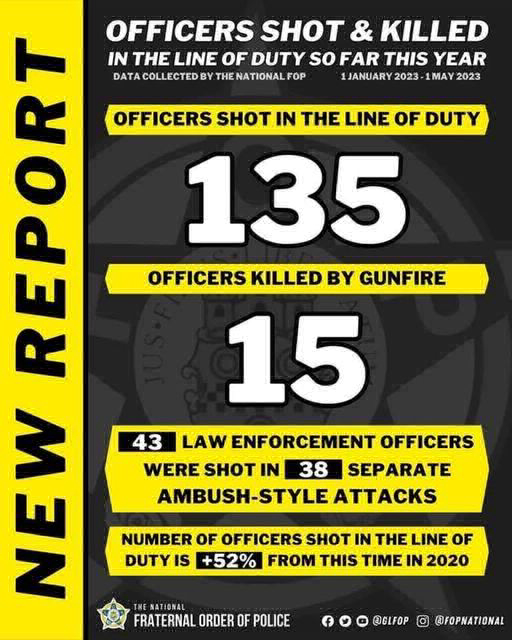While perusing social media last week, I saw that a fellow former member of service posted a graphic, shown here, covering preliminary data on law enforcement officers shot from 1 January 2023 through 30 April 2023. These are preliminary figures and may not match FBI LEOKA data.

In fact, the data appears to be taken from media accounts and not agency-submitted information. That may appropriately be of concern, but I’d also seen it reported that a number of agencies – including some of the largest – haven’t been submitting offense report data to FBI. Whether that includes “officers killed and assaulted” data, I don’t know.
In any event, I thought it fitting that we take a look at the FOP’s numbers and try to make some sense of it.
The report from National FOP shows that, as of midnight, 30 April, 135 officers were shot in the line of duty thus far in 2023. That’s up 48% from 2021 and 52% from 2020 (both year-to-date figures). Of 135 officers shot, fifteen died from their injuries.
That’s 11% -- too many if it’s even one, but that shows that the overwhelming number survived the injuries. While gunshot wounds can be disabling and disfiguring, it’s not an automatic death sentence. There is a lesson there.
The percentage killed is down from 2020 and 2021 – those January-April periods were more deadly.
Of the officers shot, 43 were shot in 38 ambush-style attacks. That’s 32% of the total. Of the officers shot from ambush, six were killed – forty percent of the total fatalities.
Ambush shootings have been more deadly.


Where did these shootings happen? They’re spread out. The majority occurred in eleven states. The most incidents occurred in individual states as follows: 11 in California and Pennsylvania, 9 in Missouri, 8 in Florida, 7 in Washington, Tennessee, Texas and Minnesota, 6 in Alabama, Indiana and Kansas.
Meanwhile, the FBI LEOKA report for 2022 was issued. “According to statistics reported to the FBI by March 1, 2023, 118 law enforcement officers were killed in line-of-duty incidents in 2022. Of these, 60 officers died as a result of felonious acts, and 58 officers died in accidents.”
The number killed feloniously was down from 2021. 20% were killed from ambush attacks.
Potential lessons?
First, all gunshot injuries aren’t fatal. We did a training segment during in-service one year in which there was a force-on-force component. Before we deployed to the training site, the participants saw a training film on fighting through gunshot injuries done by the feds. The people in the video were officers who had been shot but continued the fight and prevailed. The lesson was clear: don’t give up.
Our objective was to ensure that anyone hit during the force-on-force continue the fight and not simply stop. Fortunately, as of the time I retired nearly 10 years later, none of our people needed that training.
The ambush segment is trickier. They define ambush as being attacked without any warning or opportunity to defend against the attack. According to the National FOP site, “Premeditated ambush-style attacks are particularly disturbing and pernicious. These types of attacks are carried out with an element of surprise and intended to deprive officers of their ability to defend against the attack.”
And where does this happen? You could be on a meal break (in public), responding to a call for service that turns out to be phony, it could be when stopping a traffic violator – about anywhere, any time.
It’s best not to form a schedule habit; in the old days, it was referred to as being “predictably unpredictable.” Show up where expected, but not when. Come in from an unexpected direction.
Stop and listen before arriving at a case address. Or do a drive-by.
If you have non-uniform personnel in mixed fleet (non-marked vehicles) available, perhaps one could do a drive-by of the case address. In any event, be skeptical, suspicious – and anticipate trouble. Never stroll into any situation with your head on something else.
It doesn’t matter if you had trouble at home or if the shift supervisor is giving you a hard time or if you’re worried about bills. Keep a look-out for something or someone who doesn’t belong.
Be wary.
It’s a tough way to live, but it’s living. And it’s a good way to keep on living.
Be careful out there.
-- Rich Grassi